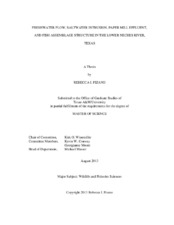| dc.description.abstract | In 2011, Texas experienced the worst drought in recorded history. This has escalated concerns regarding environmental flows needed to sustain freshwater and estuarine systems as human needs are addressed during drought periods. In this thesis, I analyze fish assemblages and water quality variables in order to observe the effects of drought in the lower Neches River below the saltwater barrier located upstream from Beaumont, Texas. Fish and water quality samples were taken during drought conditions during fall 2011 and summer 2012, after a season of rain. During fall 2011, sites surveyed above the barrier had lower salinity but similarly low dissolved oxygen (DO) levels compared with sites surveyed below the barrier. Salinity levels during fall 2011 were relatively high (reaching up to 15 ppt), whereas salinity during summer 2012 never rose above 1.5 ppt. For gillnet samples obtained during fall 2011, fish species richness was higher in December following a series of rain events than during drought conditions in October and November. Although fish species richness was similar between fall 2011 and summer 2012, species composition varied greatly. For seine samples obtained during summer 2012, species richness was higher during May and July (when the barrier was open) than during June and August (when the barrier was closed). Species richness was lowest for sites in closest proximity to a paper mill effluent discharge pipe located below the barrier. Also, species richness was higher at sites above the barrier than at sites below the barrier regardless of whether or not the barrier was closed. Multivariate statistical analyses of gillnet samples revealed a large amount of compositional overlap among fish assemblages, regardless of time period and location; however, analyses of seine samples revealed that fish assemblages above the barrier were different than those from samples obtained below the barrier and that fish assemblages varied based on time period. Results indicate that, during periods of low flow, water quality deteriorates in the Lower Neches River below the saltwater barrier. During these periods of environmental degradation, fish assemblages have reduced diversity and sensitive freshwater species decline in abundance, with some absent from survey samples. | en |


